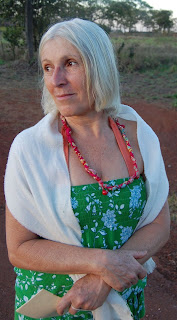 |
| Jaguar, Heloisa/copyright 2011 |
| Copyright 2011 Carola C. Reuben |
Plastic frogs pose in bikinis in downtown Chapada dos Guimaraes in Brazil’s wild west. Imitations of Chapada’s wildlife fill its shops after a soap opera made the area famous.
Chapada’s scenery was on TV for months as a backdrop for “Ana Lightening and Ze Thunder” (Ana Raio e Ze Trovao). Since soap operas run on prime time in Brazil, millions of people saw Chapada’s natural wonders.
That was about 21 years ago, and Moby then said, “aha…let’s start an eco-tourism agency,” according to Lui, Moby’s son. Moby, a teacher and historian, mapped attractions in the wilderness, researched Chapada history, and opened Eco-Turismo Cultural.
Eco-tourism pioneer Moby was among the first youths who arrived in the early 1980s seeking an alternative lifestyle.
 |
| Copyright 2011 Carola C. Reuben |
So, Eco-Turismo Cultural remains in downtown Chapada alongside tourist magnets of other stripes, including the gift shop, Mary Variedades e Presentes (photo below), and the plastic jaguar in the town square (photo, top right.)

In that mix of foreign flavors, a city dropout of the 1980s provides tastes rooted in nature.
Mazinho, 51, (photo above, right) makes popsicles and ice cream with real vegetables and fruits, including coconut, ginger, corn, guava, acai, caju, pequi.
 |
| Copyright 2011 Carola C. Reuben |
The natural treats now sell in his large ice cream parlor, Sorvetes Mazinho, but at first they were sold from a cart on the street.
Mazinho (whose real name is Vilmar) used to make crafts for a living. When that occupation literally gave him a pain in the neck, 11 years ago he started producing alternative popsicles.
Other businesses reflect the town’s counter culture. A regression therapy clinic focuses on patients’ past lives. At the Organic Vegetable Garden, workers pluck greens out of the ground as shoppers select them.
Meanwhile, some members of a younger generation give continuity to their parents’ values. Lotus, for one, was born in Chapada, but after her parents separated, she went to live with her father in Sao Paulo at the age of 9. Eventually, my niece Lotus bore a child, went to college, and worked as a teacher in the big city.
However, she kept hearing the call of the wild, and finally, in 2010 when she was 27 she returned to live in Chapada.
Her earth-saving activities include participating in a reforestation project and teaching organic vegetable gardening (photo below, right). She is also busy protesting the construction of Belo Monte, a nearby hydroelectric plant that will displace Indians.
The Jamaca valley, where Lotus was born, remains green, and there people still pursue nature-related projects.

For instance, from a thick fog Sergio suddenly emerges from the woods. He wears a camouflage shirt and leggings for protection from snakes as his camera focuses on wild animals (photo top, left). Sergio Vega, a photography professor in Gainesville, FL, USA and a native of Argentina, has been taking trips to the region for 15 years.
As the past connects with the present in other ways, seeds planted along the road by my brother Mike nearly 30 years ago have turned into a public orchard with avocados, mangos, guavas, lemons, limes, jaca, caju, genipapo.
Also on that road, Jon Kempsey, a native of UK, organizes wilderness education classes attended mostly by US youths. He is a program coordinator for the US-based National Outdoor Leadership School (NOLS).
Jon (photo above, left ) explains that he enjoys motivating future generations to preserve the Earth. He landed in an area with people who have similar values, he says. “Here, we can establish connections with people of our own mind.”
Story and photos by Carola C. Reuben.
Copyright 2011, Carola C. Reuben, Earthy Reporter
Part 3 of a 3 Part Story.
earthyreporter@aol.com











































